How to Set Up an SMPP API Server to Send and Receive SMS
The SMPP API (Short Message Peer-to-Peer) is a powerful protocol for sending and receiving SMS messages at scale. Businesses, developers, and telecom providers use it to integrate high-volume messaging into applications, ensuring fast, reliable, and secure communication. By setting up an SMPP API server with Ozeki SMS Gateway, you can create a robust system to manage SMS traffic for marketing, notifications, two-factor authentication, and more. This guide provides a step-by-step process to set up an SMPP API server using Ozeki SMS Gateway, clarifies key terms, explains each step’s importance, highlights benefits, and shares expert insights for success.
What is an SMPP API Server?
An SMPP API server (often referred to as SMPP Server) is a system that accepts incoming connections from SMPP clients, acting as an SMSC or a gateway to an SMSC. It listens for client bind requests, authenticates them, and handles SMS traffic (sending and receiving messages). The server is typically part of an SMS gateway or a custom-built system that routes messages to a mobile network or other clients. Ozeki SMS Gateway has a built in SMPP API Server.
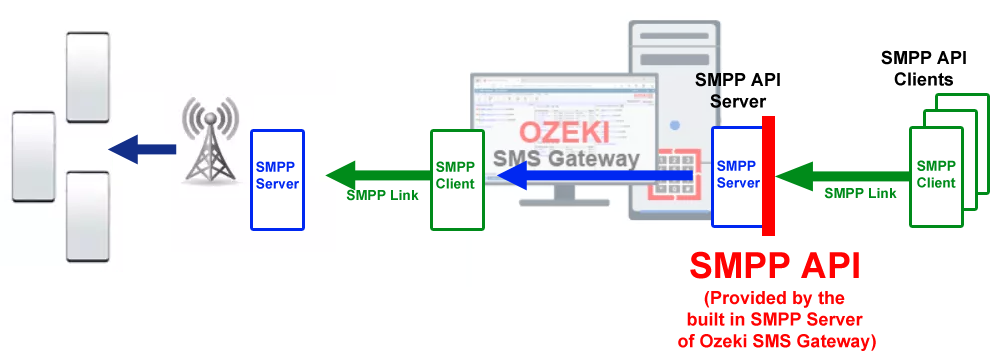
Key Characteristics:
- Role: Acts as a server, accepting connections from multiple SMPP clients.
- Function: Authenticates clients, receives SMS submissions from clients, forwards them to an SMSC or other destinations, and delivers incoming SMS or receipts to clients.
- Connection Handling: Listens on a specific port (e.g., 9550) for client bind requests and supports multiple simultaneous client connections.
- Authentication: Defines user accounts (System ID, password) for clients to connect and may enforce speed limits, binding limits and quotas.
- Use Case: Used by SMS gateways, aggregators, or enterprises to provide SMS services to multiple applications or customers, often acting as a middleman between clients and an SMSC.
Example: An Mobile Network Operator sets up an SMPP API server using Ozeki SMS Gateway to allow multiple business clients to send SMS campaigns, routing messages to an upstream SMSC.
Advantages of having your own SMPP API server:
- You can create multiple SMPP API user accounts
- You can route SMS to different mobile networks
- You can control costs, by setting SMPP quotas and credit limits
- You can keep track of all SMS messages sent/received through the system using SQL reporting
- You can regulate SMPP transfer speed and set binding limits
- You can offer SMS services through other channels, such as HTTP sms service, Excel sms, SQL-to-sms, E-mail-to-SMS
Key Differences Between SMPP API Client Connection and SMPP API Server
While both use the SMPP protocol, their roles, configurations, and purposes differ. Below is a detailed comparison:
| Aspect | SMPP API Client Connection | SMPP API Server |
|---|---|---|
| Role | Initiates connection to an SMSC or SMPP server | Accepts connections from SMPP clients |
| Primary Function | Sends/receives SMS via an external SMSC | Authenticates clients and routes SMS to/from an SMSC |
| Connection Direction | Outbound (connects to a server) | Inbound (listens for client connections) |
| Authentication | Uses credentials provided by the SMSC/server | Defines credentials for clients to connect |
| Port Usage | Connects to a server’s port (e.g., 1234) | Listens on a designated port (e.g., 9550) |
| Scalability | Single connection to an SMSC, scalable with multiple binds | Handles multiple client connections simultaneously |
| Use Case | Businesses sending SMS via a provider’s SMSC | Aggregators or gateways providing SMS services |
| Configuration Complexity | Simpler: configure credentials and SMSC details | More complex: manage client accounts, routing, and SMSC connections |
| Example Tool | Ozeki SMS Gateway as an SMPP client | Ozeki SMS Gateway as an SMPP server |
Understanding SMPP API and Ozeki SMS Gateway
The SMPP API is an industry-standard protocol that enables communication between External Short Message Entities (ESMEs), such as applications or SMS gateways, and Short Message Service Centers (SMSCs). It operates over TCP/IP, supporting high-throughput messaging, delivery receipts, and two-way SMS. Key terms include:
- ESME: An external application (e.g., Ozeki SMS Gateway) that connects to an SMSC to send or receive SMS.
- SMSC: The Short Message Service Center, a telecom component that routes SMS messages.
- Bind: The process of authenticating an ESME to an SMSC using credentials (System ID, password).
- PDU: Protocol Data Unit, the data packets used in SMPP communication (e.g., submit_sm for sending SMS).
- Transceiver: A connection mode that allows both sending and receiving SMS over a single link.
Ozeki SMS Gateway is a versatile on-premise software that implements both SMPP client and server protocols. It enables businesses to connect to mobile networks, manage SMS traffic, and integrate with applications via APIs (e.g., HTTP, SQL). Using Ozeki, you can set up an SMPP API server to provide SMS services or connect as a client to an SMSC. Its benefits include high performance, scalability, and support for multiple connection types.
Why Use an SMPP API Server with Ozeki SMS Gateway?
Setting up an SMPP API server with Ozeki SMS Gateway offers several advantages:
- High Throughput: SMPP supports sending thousands of messages per second, ideal for bulk SMS campaigns.
- Reliability: Ozeki’s automatic reconnect and load-balancing features ensure uptime.
- Scalability: Add multiple connections or users to handle growing SMS traffic.
- Security: Supports TLS/SSL for encrypted communication.
- Flexibility: Integrates with databases, HTTP APIs, and mobile devices for versatile setups.
By following this guide, you’ll create a robust SMPP API server to send and receive SMS, leveraging Ozeki’s powerful features.
Step-by-Step Guide to Setting Up an SMPP API Server with Ozeki SMS Gateway
Below is a detailed, step-by-step process to set up an SMPP API server using Ozeki SMS Gateway. Each step includes the rationale and benefits to ensure clarity.
Step 1: Install Ozeki SMS Gateway
Action: Download and install Ozeki SMS Gateway on a Windows or Linux computer.
How: Visit the Ozeki SMS Gateway download page and select the appropriate version for your operating system. Run the installer and follow the prompts to complete the installation.
Why: Ozeki SMS Gateway is the core software that implements the SMPP protocol. Installing it provides the foundation for your SMPP API server, enabling both client and server functionalities. The software’s user-friendly GUI simplifies configuration.
Insight: Ensure your system meets Ozeki’s requirements (e.g., Windows 10/11 or Linux, 4GB RAM, stable internet). A physical or virtual machine works, but a dedicated server is ideal for high-volume messaging.
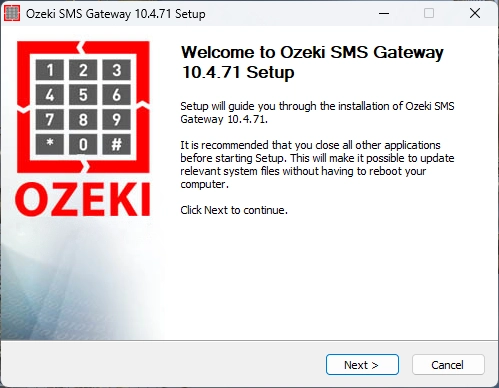
Step 2: Launch Ozeki SMS Gateway and Access the Management Console
Action: Open Ozeki SMS Gateway and log in to the management console.
How: After installation, launch Ozeki SMS Gateway. It automatically opens the management console in your default browser (preferably Chrome or Edge). Log in with the default credentials (username: admin, password: abc123) or your custom credentials.
Why: The management console is Ozeki’s interface for configuring connections, users, and routing rules. Accessing it allows you to set up the SMPP API server and manage SMS traffic.
Insight: Change the default password after logging in to enhance security. The console’s intuitive design makes it accessible even for those new to SMPP API setups.
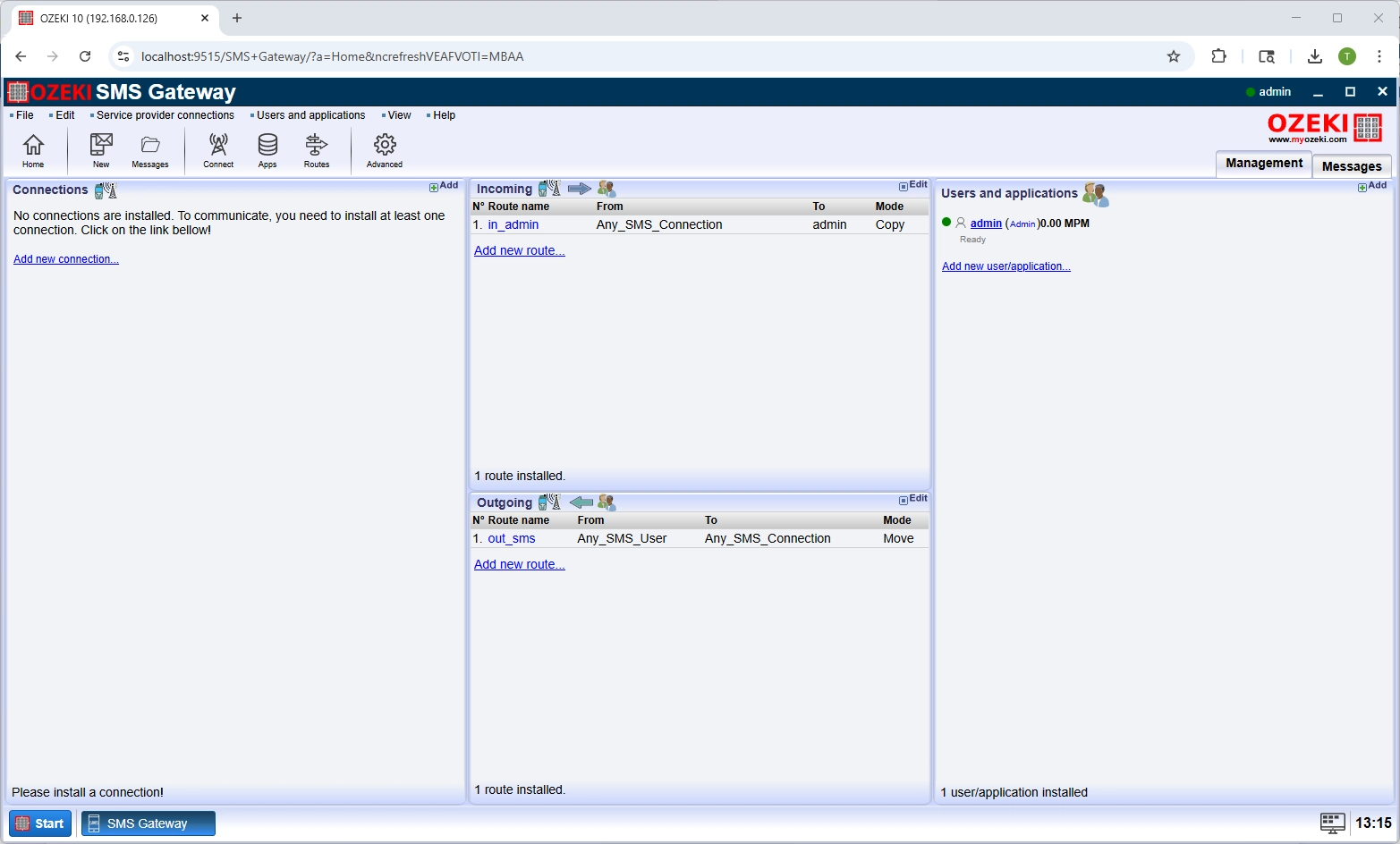
Step 3: Create an SMPP Service
Action: Set up an SMPP service to act as the SMPP API server.
How: In the Ozeki management console, navigate to the “Advanced” menu and click “Create new Service.” Select “SMS Service” and choose “SMPP.” Enter a unique service name (e.g., “SMPP_Server”), set the System ID to “OZEKISYSTEM,” and use the default port 9550. Click “OK” to create the service.
Why: The SMPP service configures Ozeki as an SMPP API server, allowing client applications to connect and send/receive SMS. The System ID and port are critical for client authentication and communication.
Insight: Use a descriptive service name for easy identification, especially if you plan to run multiple services. Port 9550 is standard, but ensure it’s not blocked by your firewall.
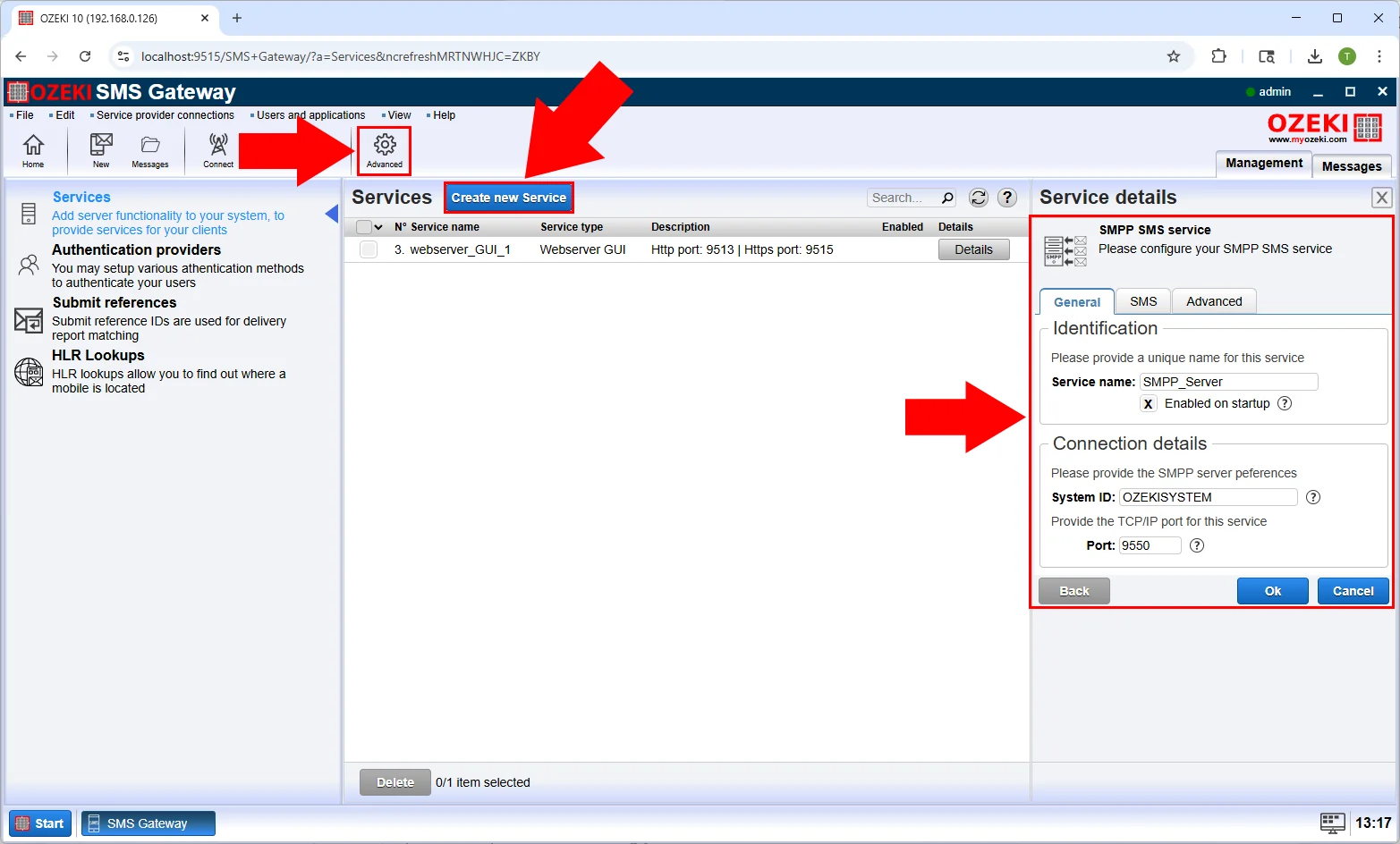
Step 4: Configure an SMPP User Account
Action: Create an SMPP user account for client applications to connect to your SMPP API server.
How: In the management console, click “Add new user/application” in the “Users and Applications” panel. Select “SMPP User.” Provide a unique username (e.g., “smppuser”) and a strong password. Optionally, set a speed limit to control message throughput. Click “OK” to save.
Why: SMPP user accounts authenticate client applications connecting to your server. This ensures only authorized systems can send/receive SMS, enhancing security and control.
Insight: For high-volume scenarios, configure multiple user accounts to segregate traffic (e.g., one for marketing, another for OTPs). Speed limits prevent overloading your server.

Step 5: Connect to a Mobile Network
Action: Set up a connection to a mobile network to route SMS messages.
How: In the “Service Providers” panel, click “Add new service provider connection” and select “SMPP Client.” Enter the SMSC’s host address, port, username, password, and sender ID (phone number or alphanumeric ID) provided by your SMS service provider. Check the “overridable” box for flexible sender IDs. Click “OK” to save.
Why: An SMPP client connection links your Ozeki SMS Gateway to an SMSC, enabling SMS delivery to mobile devices. The sender ID defines how recipients see the message sender.
Insight: Contact your mobile network operator or SMS provider for SMPP credentials. For testing, consider using Ozeki’s Android SMPP SMS Gateway app as an SMSC substitute (learn more).

Step 6: Set Up Routing Rules
Action: Configure inbound and outbound routing rules to manage SMS traffic.
How: In the “Routes” panel, click “Add new route.” For outbound SMS, set the “From” connection to the SMPP user (e.g., “smppuser”) and the “To” connection to the SMPP client (SMSC). For inbound SMS, reverse the direction. Save the rules.
Why: Routing rules direct messages between users and the mobile network. Outbound rules send SMS from clients to the SMSC, while inbound rules deliver received SMS to clients.
Insight: Use load balancing by creating multiple SMPP client connections with the same name (e.g., “Provider1”) to distribute traffic evenly, improving performance.

Step 7: Test the SMPP API Server
Action: Send and receive test SMS to verify the setup.
How: In the SMPP client connection’s “Test” tab, enter a recipient phone number (in international format, e.g., +1234567890), type a test message, and click “Send.” Check the “Events” tab for logs showing “Connection online” and “Successful login.” For receiving, send an SMS to the configured sender ID and verify it appears in the SMPP user’s inbox.
Why: Testing confirms that your SMPP API server is correctly configured and communicating with the SMSC. Logs help identify issues like authentication failures or network errors.
Insight: Enable detailed logging initially to troubleshoot, but disable it for high-performance setups to reduce disk I/O.
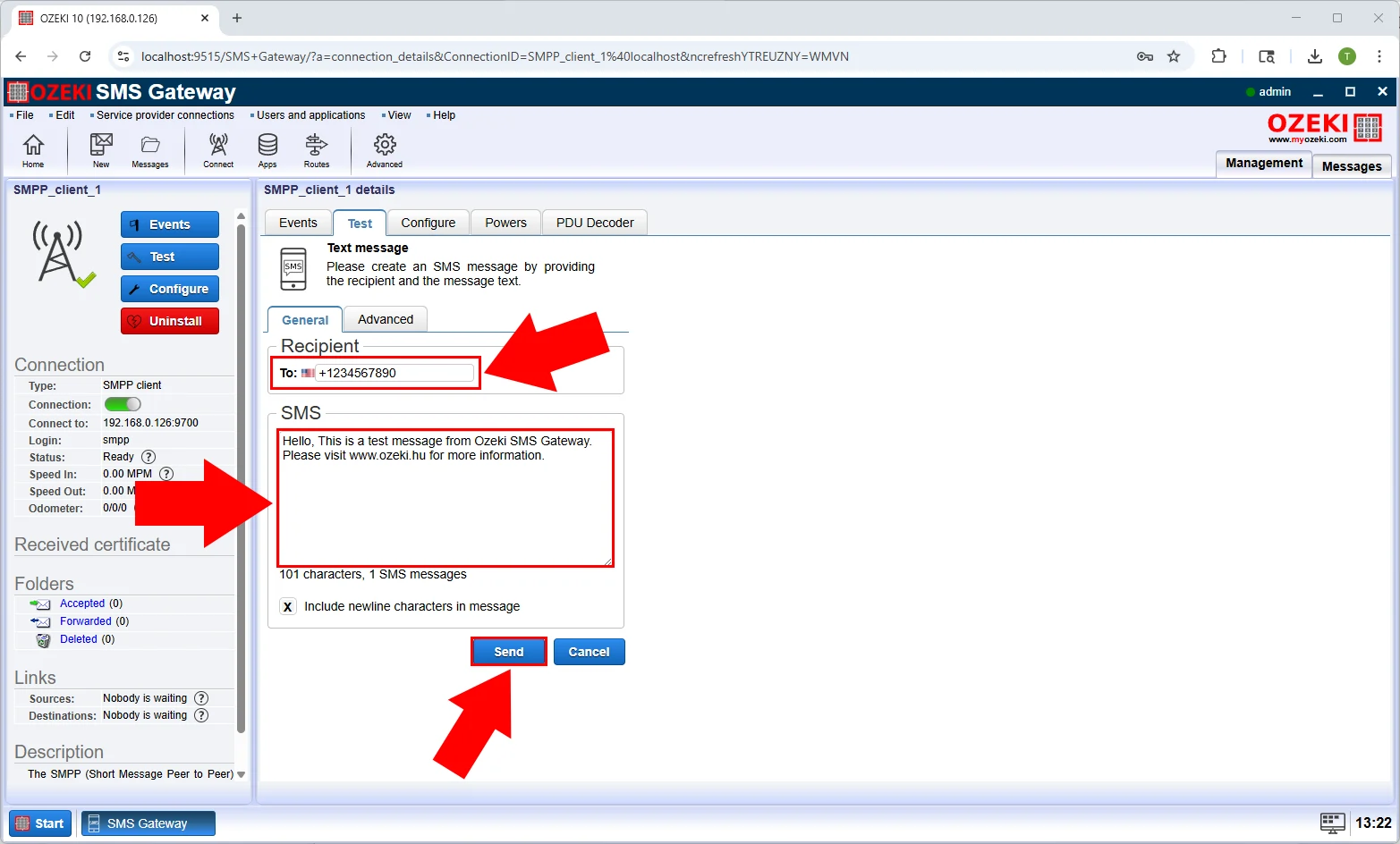
Step 8: Secure the SMPP API Server
Action: Enable TLS/SSL for encrypted communication.
How: In the SMPP service configuration, enable the “Use SSL” option and configure SSL certificates. Consult your SMS provider for SSL requirements and obtain certificates if needed. Restart the service to apply changes.
Why: TLS/SSL encrypts SMPP API traffic, protecting sensitive data like user credentials and message content from interception.
Insight: SMPP v3.4 supports SSL better than v3.3. If your provider supports v3.4, use it for single-link transceiver mode, reducing complexity.
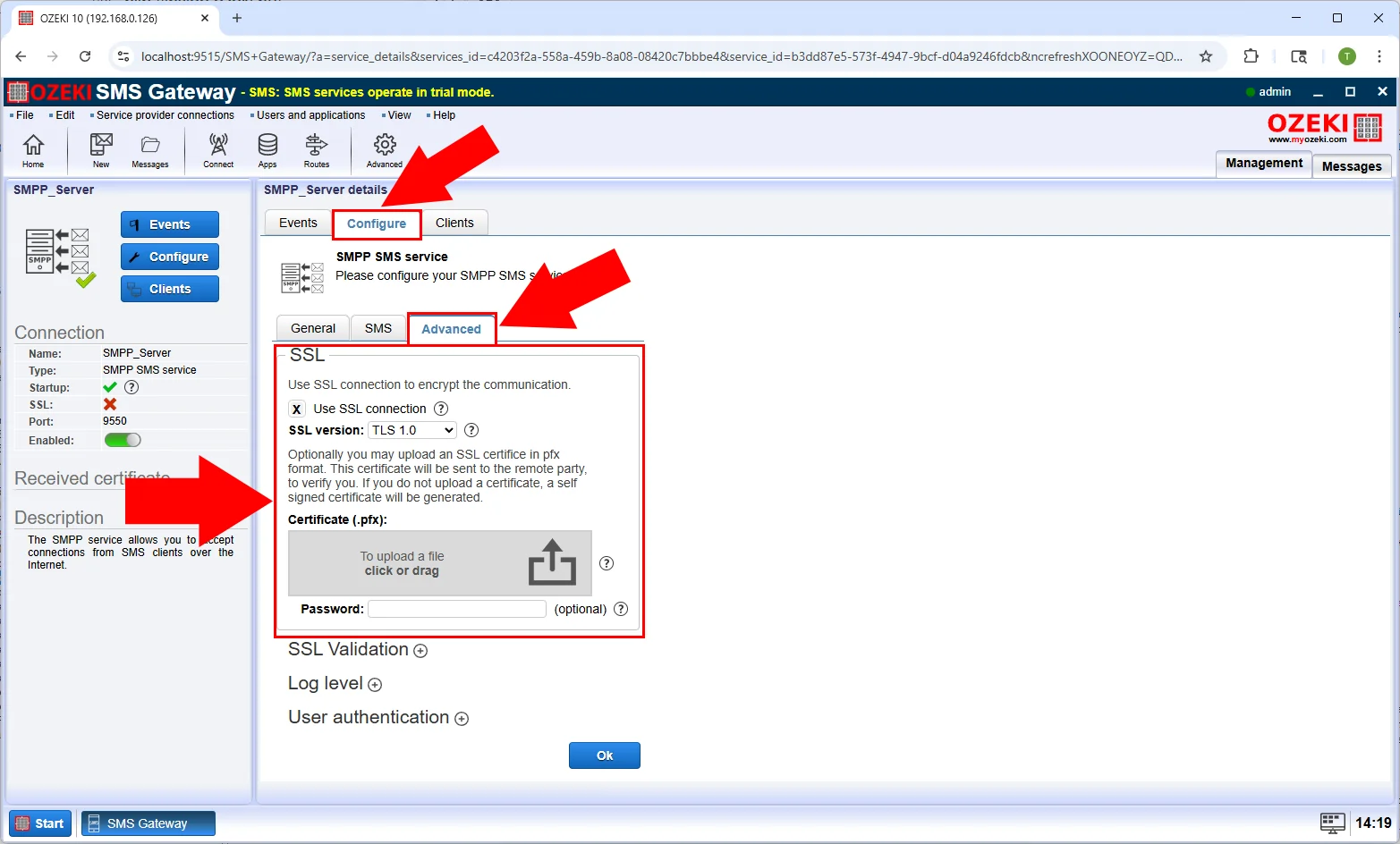
Step 9: Integrate with Applications
Action: Connect applications to your SMPP API server for automated messaging.
How: Use Ozeki’s HTTP API, SQL integration, or SMPP client libraries (e.g., Java, Python) to connect applications. For example, configure a database user to send SMS from a MySQL table . Provide applications with the SMPP server’s IP, port (9550), and user credentials.
Why: Integration allows applications to leverage your SMPP API server for automated tasks like sending OTPs or notifications, enhancing functionality.
Insight: Ozeki’s HTTP API is simpler for web developers, while SMPP clients suit high-volume applications. Test integrations in a staging environment to avoid disruptions.
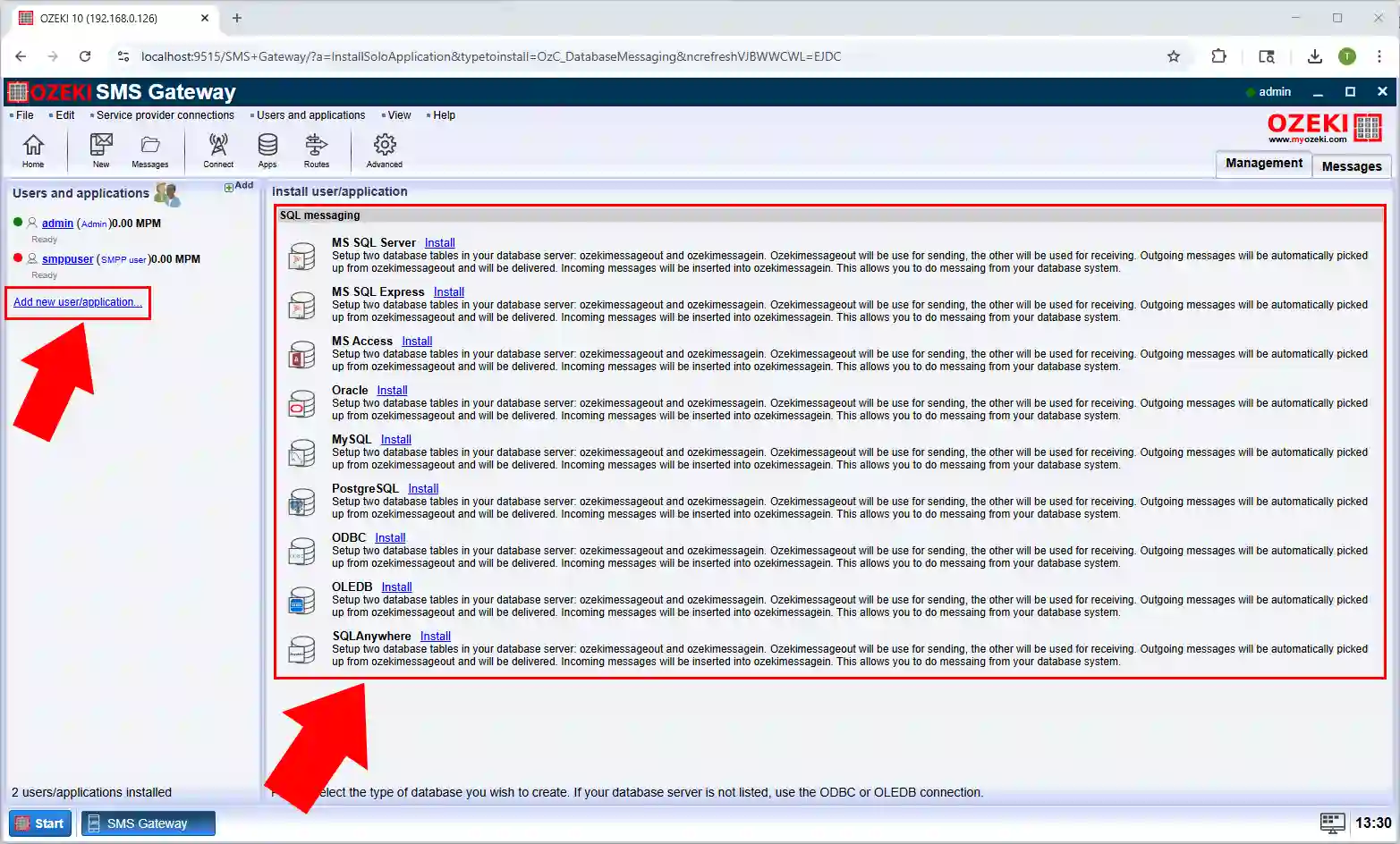
Step 10: Monitor and Optimize Performance
Action: Monitor logs and optimize for high throughput.
How: Check the “Events” tab for connection status and errors. Use Ozeki’s SQL reporting to track message volume and delivery status. Adjust user speed limits or add connections for load balancing if needed.
Why: Monitoring ensures reliability and helps identify bottlenecks. Optimization maintains performance under heavy loads.
Insight: For large-scale setups, use Ozeki’s cluster feature to distribute load across multiple servers, ensuring uptime and scalability .
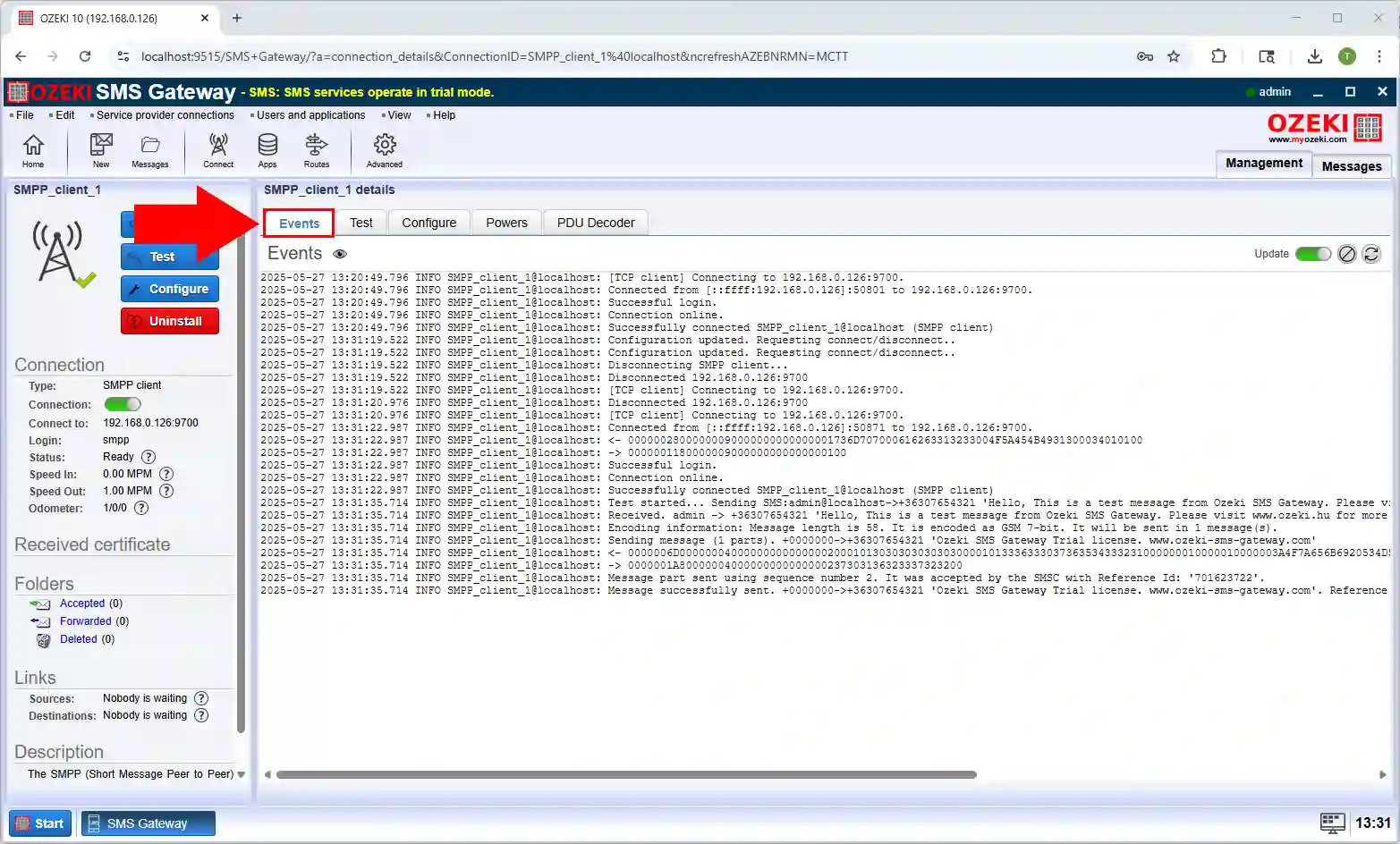
Benefits of Using Ozeki SMS Gateway for SMPP API
Using Ozeki SMS Gateway for your SMPP API server delivers:
- Cost Efficiency: On-premise setup reduces dependency on third-party services.
- Customization: Tailor user accounts, routing, and integrations to your needs.
- Reliability: Automatic reconnect and failover ensure uninterrupted service.
- Global Reach: Connect to multiple SMSCs for international messaging.
Expert Insights for SMPP API Success
Choose the Right SMPP Version: SMPP v3.4 is preferred for its single-link transceiver mode and TLV support, simplifying setup and enabling non-GSM networks.
Test with Ozeki Android SMPP Gateway: For small-scale or testing setups, use the Ozeki Android SMPP Gateway app to turn a smartphone into an SMSC, avoiding provider costs during development.
Plan for Scalability: Start with one connection and scale by adding more SMSC links or user accounts as traffic grows.
Secure Your Setup: Always enable TLS and use strong passwords to protect your SMPP API server.
Leverage Logging: Use Ozeki’s SQL reporting to analyze message patterns and optimize campaigns.
Conclusion
Setting up an SMPP API server with Ozeki SMS Gateway is a straightforward yet powerful way to manage SMS communication. By following these steps, you can create a scalable, secure, and reliable system to send and receive SMS for various applications. Ozeki’s robust features, from load balancing to HTTP integration, make it an ideal choice for businesses and developers. Start your SMPP API journey today by downloading Ozeki SMS Gateway from ozeki-sms-gateway.com and unlock the potential of high-volume SMS messaging.
